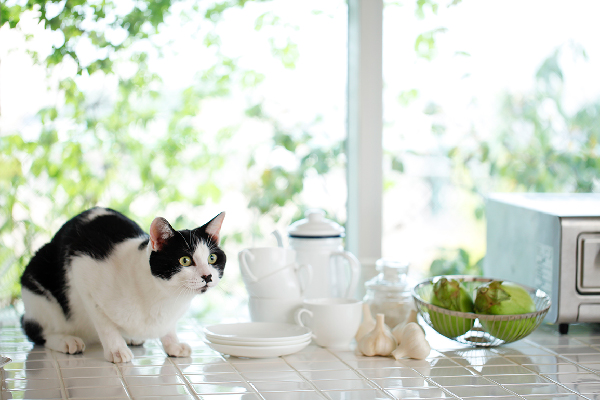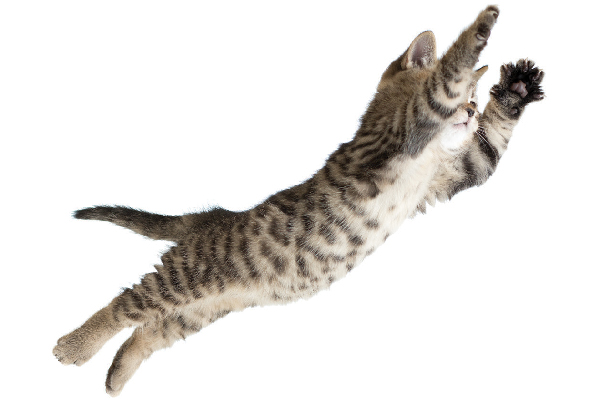Many cats naturally aspire to great heights, which means they sometimes land on counters, a common no-no in households. Those who wish to change this counter-cruising habit often wonder if there’s a tried-and-true solution. There are a few solutions, and the first step is determining the reason why the cat gravitates to the elevated counter space.
Reasons cats like to jump on counters
- There are desirable items — like food — readily accessible.
- The counter is a “roadway” to an enticing spot, like a windowsill.
- There’s fresh, running/dripping water available from a sink.
- They’re bored.
- They simply enjoy the elevation.
Ways to keep cats off of counters
Keep the counter space clear of alluring objects. This means placing food in cabinets and re-homing bag clips and other toy-like objects.
Add a tall cat condo or tree to satisfy the cat’s need for height. If possible, place it by a favorite window so kitty has easy, “legal” access to the spot. Or create a new favorite perch by placing a bird feeder outside a window.

Repair leaky faucets, eliminating the draw of running water available by counter access. Perhaps offer the cat a water fountain that provides fresh, moving refreshment — on the floor.
If a chair is helping kitty jump, remove it.
Increase playtime with a cat who’s easily bored. Sometimes counter cruising behavior is a cry for attention, and extra engagement with kitty can satisfy that need and burn extra energy.
Cats don’t like sticky surfaces. Add double-sided tape to one side of cheap, plastic placemats and line the counter space with them. If the cat jumps onto the counter, the discomfort will likely cause her to retreat.
Reward positive behavior. If kitty jumps onto the cat tree instead of the counter, praise her with extra pets and attention or an occasional treat. Animals repeat what benefits them.
Considerations
Don’t punish the cat. He doesn’t make the connection between the punishment and the behavior that resulted in the punishment. Verbal and physical punishment can create fear of the human and even cause the cat to act out.
Some humans rely on a spray bottle as a deterrent to counter cruising. Unfortunately, this method creates a negative association between the human and the spray bottle — not necessarily between the bottle and the behavior. Additionally, kitty may continue with the behavior when the human isn’t around, which doesn’t ultimately change the problem.
There are safety issues associated with jumping onto a counter. Hot surfaces can burn sensitive paws, and dangerous kitchen items like knives pose a threat to curious kitties.
Humans — especially those with compromised or weak immune systems — could be at risk for sanitary issues associated with bacteria from dirty feline paws.
Make sure all family members are onboard with the plan. Consistency is key when it comes to behavior modification.
If all attempts to derail counter cruising don’t seem to work, contact a cat behaviorist for a consultation.
Dr. Marci Koski of Feline Behavior Solutions advises, “When it comes to training cats to curb behaviors, the important thing is to provide an appropriate outlet for the need that drives them to that behavior in the first place. This includes scratching furniture, ambushing people for play and, yes, jumping up on counter tops. Just because you tell them ‘Don’t do that!’ doesn’t mean that the instinctual drive to do a behavior stops — they have a need that must be met in some other way. Cats who like to counter surf want to be up high to see what’s going on, so give them a place to do that — an alternative — that works for both of you. If your cat is doing it because she’s hungry, keeping food off the counters will help, but she’ll still be hungry; feed her more frequent, smaller meals, or use food puzzles to help meet her needs.”
More about the author:
Angie Bailey, an award-winning writer, podcaster, and humorist, is the author of Texts from Mittens and Whiskerslist: The Kitty Classifieds. She’s written cat humor for over a decade, and lives in Minneapolis with her fiancé and two cats — Phoebe, a sassy senior and Janet, a teenage kitty with tons of tortitude.








